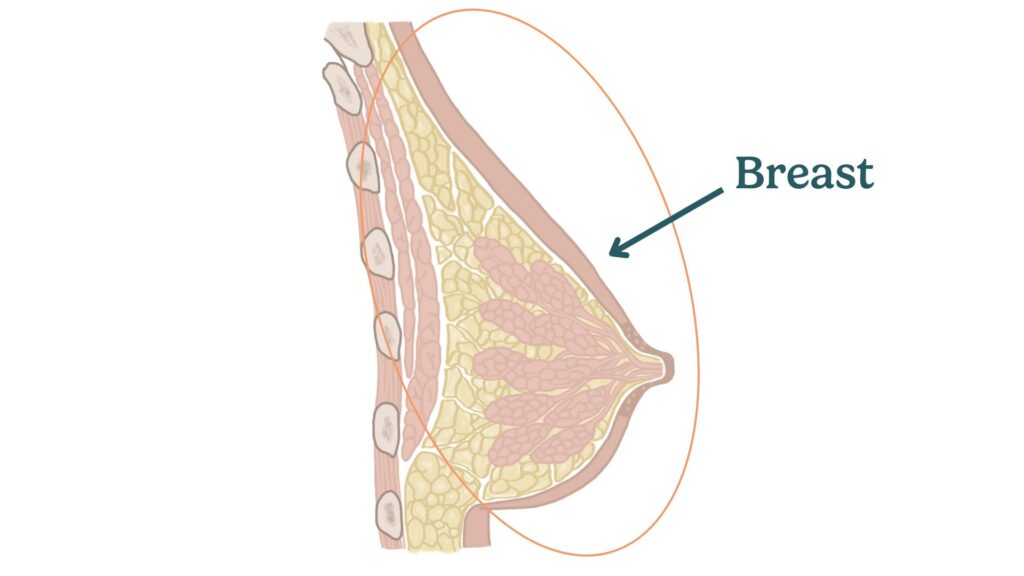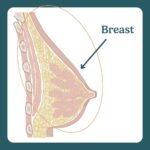breast

What is the breast?
The breast is a complex organ primarily composed of glandular tissue, fat, and connective tissue. It plays a crucial role in breastfeeding by producing and delivering milk to your baby. Each breast contains lobes, which are divided into smaller lobules that house alveoli, the tiny sacs where milk is produced.
The milk travels through a network of ducts that lead to the nipple, where it is accessible to your baby during breastfeeding.
What to watch out for
Engorgement
Engorgement occurs when your breasts become overly full of milk, making them feel hard, swollen, and painful. This can happen if your baby is not feeding often enough or if you have an oversupply of milk. Engorgement can also be caused by excess fluid (edema), often resulting from IV fluids administered during labor and delivery. To relieve engorgement, nurse your baby frequently, use cold compresses between feedings, and hand express or pump a small amount of milk to soften the breast before feeding.
Engorgement typically resolves within a few days to a week. If it persists, consult a healthcare professional or lactation consultant. Read more about engorgement and how to manage it.
Mastitis
Mastitis is an infection of the breast tissue that can cause pain, swelling, redness, and flu-like symptoms. It often occurs when a blocked duct is not cleared, leading to infection. If you suspect mastitis, seek medical help.
Continue breastfeeding or pumping during this time to help clear the infection. Antibiotics may be required, and early treatment is essential to prevent complications. Read up on mastitis.
Blocked ducts
Blocked ducts occur when milk becomes trapped, causing localized pain and a firm lump in the breast. To clear a blocked duct, continue breastfeeding or pumping, gently massage the affected area, and apply cold compresses after breastfeeding.
Blocked ducts usually resolve within 24-48 hours. If the issue persists or shows signs of infection, seek medical advice. Learn more about plugged ducts and how to prevent them.
Nipple pain
Nipple pain can result from poor latch, engorgement, or infections like thrush. Make sure your baby is latching properly by seeking guidance from a lactation consultant. Use nipple balm to soothe and protect your nipples.
If pain persists or you notice signs of infection, consult a healthcare professional. Read more about a good latch and other tips.
Physical limitations or health circumstances
Breast surgery
Previous breast surgeries, such as augmentation, reduction, or mastectomy, can impact milk production and the ability to breastfeed. The extent of the impact depends on the type of surgery and techniques used.
Discuss your history with a lactation consultant to develop a breastfeeding plan. Read more about breastfeeding with implants.
Insufficient glandular tissue (IGT)
IGT is a condition where the breast tissue does not fully develop, leading to fewer alveoli and milk ducts. This can result in a low milk supply.
Working with a lactation consultant can help maximize milk production and explore supplementation options if necessary. Learn more about low milk supply.
Inverted or flat nipples
Inverted or flat nipples can make it difficult for your baby to latch properly, affecting milk transfer. Using nipple shields and practicing different breastfeeding positions can help improve the latch.
Consult a lactation consultant for personalized advice.
Nipple shields: All You Need to Know
Nipple Shield Recommendations from an IBCLC
Hormonal imbalances
Conditions like polycystic ovary syndrome (PCOS) or thyroid disorders can affect hormone levels and milk production. Managing these conditions with the help of a healthcare provider can support successful breastfeeding.
Other terms
Understanding these additional terms related to the breast and breastfeeding process can help you navigate their breastfeeding journey as a new mama:
- Alveoli: Tiny sacs in the breast where milk is produced.
- Ducts: Small tubes that transport milk from the alveoli to the nipple.
- Oxytocin: A hormone that causes the muscles around the alveoli to contract and release milk, known as the let-down reflex.
- Prolactin: A hormone responsible for stimulating the alveoli to produce milk.
- Lactogenesis: The process of initiating and maintaining milk production in the breast.
- Colostrum: The first milk produced, rich in nutrients and antibodies, providing crucial immune support for your newborn.
- Engorgement: Overly full breasts that can cause pain and swelling.
- Mastitis: An infection of the breast tissue causing pain, swelling, and flu-like symptoms.


